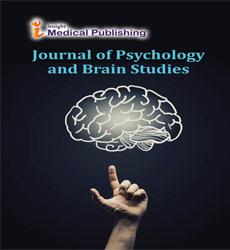Post-menopausal Depression or Anxiety
Robert Coin*
Department of Psychology, University of Southern Queensland, Springfield Central, Australia
- *Corresponding Author:
- Robert Coin
Department of Psychology
University of Southern Queensland, Springfield Central, Australia
E-mail: coinrob23@yahoo.com
Received Date: December 07, 2021; Accepted Date: December 21, 2021; Published Date: December 28, 2021
Citation: Coin R (2021) Post-menopausal Depression or Anxiety. J Psychol Brain Stud Vol. 5 Iss No.12:58.
Changes in menstrual bleeding patterns indicate the onset of menopause in midlife women, and many women suffer hot flashes, insomnia, depression, and other symptoms in addition to these menstrual changes. The extent to which symptoms linked with menopause are directly related to ovarian ageing hormone alterations is unknown. Many potential risk factors and the function of the changing hormone milieu linked with sad mood during menopause are being studied, but no conclusive solutions have been found. Menopause is defined retroactively as the last menstrual period followed by 12 months of amenorrhea. The period following the last menstrual period is referred to as post-menopause. A woman's ovary is her only supply of oocytes, her primary source of oestrogen and progesterone, and a substantial source of androgens. Menopause causes infertility due to oocyte depletion. Except for the increased risk of endometrial proliferation, hyperplasia, and cancer associated with continuing endogenous oestrogen production or administration of unopposed oestrogen therapy in menopausal women, ovarian progesterone suppression appears to have no clinical repercussions. Depressive symptoms are widespread in all groups, although they tend to be more prevalent in women throughout the menopause transition.
According to the National Comorbidity Survey, women have a higher lifetime prevalence of major depression than males in all age categories until late life, with a lifetime prevalence of 21% compared to 12% for men. Women are more likely than men to acquire a Major Depressive Disorder (MDD) during their lives. Whereas the risk is 1.7 times higher in women during their reproductive years, no significant variations have been detected during childhood or among elderly women in their late postmenopausal years, implying a probable link between increased risk for depression in women and reproductive years. Menopause is described as the last menstrual period caused by ovarian function decrease. Menopause, on the other hand, is not a sudden and isolated event in a woman's life. It's a biological process that begins many years before the last menstrual period. The shift from reproductive to menopausal life also symbolises a stage in life when considerable psychological obstacles, emotional upheavals, and the onset of physical symptoms related with the steady decline of ovarian function may occur. Cross-sectional studies that examined psychological distress or depression in women during the menopausal transition yielded conflicting results, owing primarily to methodological discrepancies.
Two major community-based studies indicated that postmenopausal women had higher levels of psychological discomfort and depressive symptoms than premenopausal women. Women's depression appears to rise around reproductive events as well. Postpartum depression, premenstrual dysphoric disorder connected to the menstrual cycle, and menopausal depression may all share sensitivity to natural variations in reproductive hormones, which in turn regulate neuroregulatory systems associated with mood and behaviour. Several open studies have shown that selective serotonin reuptake inhibitors (SSRIs) and serotonin norepinephrine reuptake inhibitors (SNRIs) are effective in reducing vasomotor symptoms in perimenopausal and/or postmenopausal women. Open trials with citalopram and escitalopram monotherapy shown a high incidence of remission of depressive symptoms (86.6 percent and 75 percent, respectively).
One of the most contentious concerns in the menopause transition is the relationship between depression and menopausal status. Epidemiologic studies based on self-report of menopausal status and depressed mood consistently found that most respondents did not report high rates of depressive symptoms, and that reported depressive symptoms were connected with other health conditions rather than menopause. 28.9% of women aged 45–54 years exhibited a high level of depressive symptoms based on a shortened CES-D scale, although there was no relationship between the depressive symptoms and menopausal state as described by the women's perspectives.
Open Access Journals
- Aquaculture & Veterinary Science
- Chemistry & Chemical Sciences
- Clinical Sciences
- Engineering
- General Science
- Genetics & Molecular Biology
- Health Care & Nursing
- Immunology & Microbiology
- Materials Science
- Mathematics & Physics
- Medical Sciences
- Neurology & Psychiatry
- Oncology & Cancer Science
- Pharmaceutical Sciences
